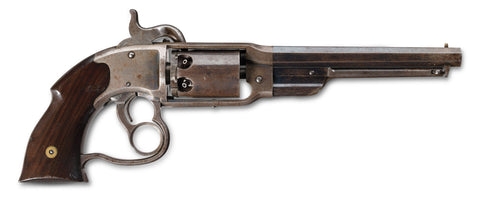
This Ugly Revolver Was Actually Technologically Advanced For Its Time
The Civil War kicked off a demand for firearms just as industrial technology allowed gunsmiths to tinker with various designs, and numerous handguns were developed with the hopes of obtaining military contracts. Some of those weapons were sleek and well-balanced. And then there was the poorly balanced and odd-looking Navy revolver produced by the Savage Revolving Firearms Company of Middletown, Conn., which had a reputation for producing unusual and unique weapons.
The two triggers sported by the revolver were its most distinctive feature. The lower “ring” trigger was in reality more of a lever that rotated the cylinder and cocked the hammer at the same time. The upper trigger’s purpose was conventional in that it fired the weapon.
Though clumsy in appearance, the Savage Navy was a step toward double- action—meaning a revolver could be repeatedly fired simply by pulling its trigger. Revolvers at the time were single-action in that the user had to manually cock the hammer between each shot to rotate the cylinder.
The U.S. government first contracted with Savage on October 16, 1861, to buy some of the revolvers, and eventually purchased 12,000 of them. They were issued to 26 Union cavalry regiments, including units from Illinois, Kansas, Kentucky, Missouri, New York, Ohio, Pennsylvania, Wisconsin, Vermont, and the Potomac Home Brigade. Even some Confederate cavalry regiments from Texas and Virginia were issued Savage Navys privately bought and secretly shipped south.
Fifty Savage revolvers were even sent for use aboard the famous USS Constitution in 1861. That ship was used as a training vessel for at the Naval Academy in Annapolis, Md.
Sidearms could be issued to
sailors to repel boarders or when they went on land expeditions, and the U.S.
Navy purchased 1,126 Savage Navy revolvers for $20 each. The example above
bears the approval stamp of Commander John R. Goldsborough, right, who was one
of the Navy’s primary inspectors of the revolvers.
Most revolvers had
only one mainspring hidden away in the hand grip, but the Savage required two.
One to rotate the cylinder and cock the hammer, and the other to release the
trigger. The 1860 patent drawing shows Savage’s “Figure 8” revolver, named for
the shape of the two triggers. It preceded the Savage Navy.
These images of Union troops showing off their Savage
Navys give a sense of scale on how large the 3-pound-7-ounce pistol was. Was
the cavalryman at left a Dapper Dan or a Fop man? Either way, let’s hope the
revolver stuck in his belt isn’t loaded. The subject in the right image had
the photographer tint the cylinder nipples to simulate percussion caps.
The Savage
company also produced ammunition for its Navy revolver, though the gun could
use cartridges produced by other firms. Savage made “skin cartridges,” meaning
a small tube made out of thin animal intestine and full of gunpowder was glued
to the base of the lead bullet. The entire cartridge could be placed in a
cylinder, and the skin tube burned up upon firing. This box contained a
cylinder’s worth of rounds.
